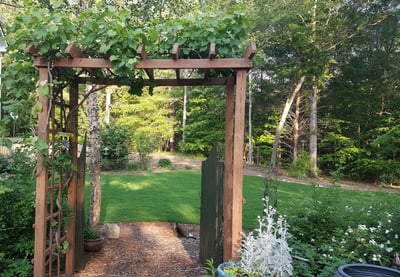

Pre-emergent Herbicide is our #1 Trick for Weed Control


Are you ready to break the weed cycle and stop weeds before you even see them?
Then this article about pre-emergent herbicide is for you! I'll explain why pre-emergent herbicide is the best method for weed control in your lawn. Pre-emergents are not just what we recommend for homeowners, they're also what we use on the sod farm for controlling weeds. It's hard to have a weed-free lawn without them.
What is Pre-emergent Herbicide?
There's a key difference between pre-emergent and post-emergent herbicide, and that is when they are applied in a weed's lifecycle for weed management.
Pre-emergent forms a chemical barrier on the ground that prevents weed seeds from fully germinating. With a pre-emergent, the first tiny root germinates and hits the chemical barrier and dies, thus killing the first growth from a seed, weakening it, and preventing the leafy part of the seed from germinating or "emerging." So, pre-emergents (like our granular 0-0-7 and 16-4-8 fertilizer with pre-emergent) give you the option to take care of those weeds before they ever become an eyesore.
Post-emergent herbicides (like our liquid Quincept and 3-Way Max) work opposite in that a weed actually has to be present (or it has to have "emerged") for the herbicide to coat the leaf and kill the weed.
What Type of Pre-Emergent is Best?
On the farm we've been growing sod for over 70 years now, and we've used nearly every pre-emergent you could possibly imagine. After all that time we think granular Prodiamine is the best fit for the homeowner - the trade name for that one is "Barricade."
We offer two types of granular Barricade pre-emergent herbicide online and in our stores.
How to Apply Granular Pre-Emergent Herbicide
Applying granular pre-emergent for weed prevention is as easy as spreading fertilizer. Simply follow these steps:
- Established Lawns: Apply only to established lawns (more information and precautions in the sections below).
- Use a Spreader: Procure a walk-behind, push spreader. We offer our yellow spreader and we include the settings for all our granular products.
- Follow Recommended Rates:
- 25 lb. bag covers up to 4,000 sq. ft.
- 50 lb. bag covers up to 8,000 sq. ft.
- Make 2 Passes with the Spreader: Best practice to ensure even coverage on your lawn is to apply the product in two passes. First half is applied in north-south direction and the second half in a pass going east-west. Once you know the settings for your spreader, make sure you are using the setting for applying half of the total recommended amount of lawn treatment product for each pass.
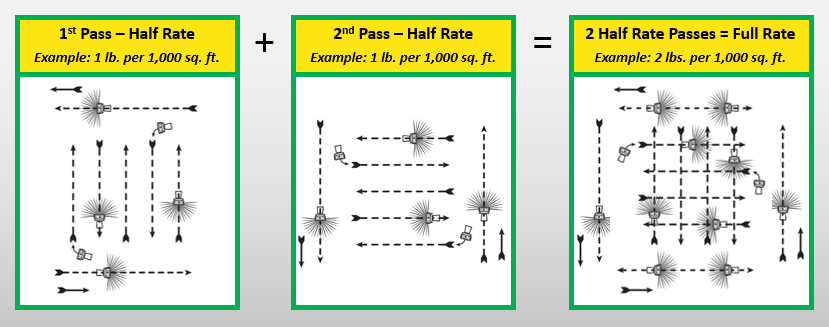
- Time of Day Matters: Spread pre-emergent in the evening or in the morning before temperatures rise above 80 degrees; do not apply during the heat of the day.
- Activate it with Water: To activate the pre-emergent, it must be "watered in" within 24 hours. Do so by turning on your irrigation long enough to deliver 1/2" of water.
What Factors Reduce Performance of Pre-emergent Herbicide?
There are several things that affect the weed control performance of pre-emergent herbicide:
- Too little water: You have to get it watered in as soon as you apply it or at least within 24 hours.
- Too much water: Too much rain is also something that can really limit the protection you get from pre-emergent - obviously that's not something you can control but if we have a particularly rainy season you need to understand that your pre-emergent is not going to perform the way you thought it would.
- Bad timing: This is probably the biggest mistake we see with pre-emergents: if you wait until the weed is already there, or even if it's not visible but the weed seed is germinated, then the pre-emergent is going to provide you no control over that weed.
- Disruptive Lawn Care Activities: There are several management activities that can also limit the performance of pre-emergent, namely dethatching and aerating while you're depending on that pre-emergent for control because it disrupts the chemical barrier.
Where to Use Pre-Emergents Herbicide?
Feel free to use pre-emergent herbicide on your lawn and your ornamental beds.
The one thing I would say is if you plan on planting flowers by way of seed or overseeding your lawn within the next 3-4 months, you do not want to use pre-emergents as they will prevent those seeds from germinating too.
Other Reasons to Choose Pre-emergent Instead of Post-emergent
- Cheaper to Use: There are several reasons but first and foremost they're cheaper. Take Poa annua for an example - it's a very expensive weed to control once it's established in your lawn but pre-emergent will take care of that before it ever even becomes a problem. Think about how little chemical is needed to kill a plant before it gets established versus how much it takes to kill that plant once it's grown up and is established.
- Ease of Use: Pre-emergents are so much easier to use than a post-emergents because they are granular. There are several post-emergent herbicides that come in a granular form but most are liquid. Most pre-emergents are granular, such as our Barricade. A granular form is a better option than liquid for spreading thoroughly and evenly on your lawn and preventing injury to other plants.
- More Effective: Pre-emergents are much more effective than post-emergents. Again, using Poa annua as an example - it is very very expensive and very difficult to take out of a lawn but with a pre-emergent you're getting rid of that weed before it ever even becomes a problem, so they're much more effective.
- Yearly Improvement: Pre-emergent, if you stay on the program, will get better every single year because you're not not allowing those plants to grow up and distribute more seeds into your soil bank. Thus you'll have less and less weed pressure every single year.
- Less Risk for Other Plants: Pre-emergents create much less contact with non-target plants especially when you take into account the spray drift you get from using a liquid post-emergent. Things like ornamental plants, rose bushes, and even vegetable gardens are not at risk of having their leaves accidentally sprayed by using granular pre-emergents.
- More Environmentally Friendly: Pre-emergents are actually a much greener option as well. First off, as we've already covered, they use a lot less chemical. We would never recommend something for your lawn that's not safe for you and your family but common sense says the less herbicide you have to use, the better off you're going to be. So again, pre-emergents are a much greener option for that reason.
- Less Exposure: Pre-emergants are actually much safer to use as well. There is so much less exposure for you, your kids, and your pets when you're on a good pre-emergent routine.
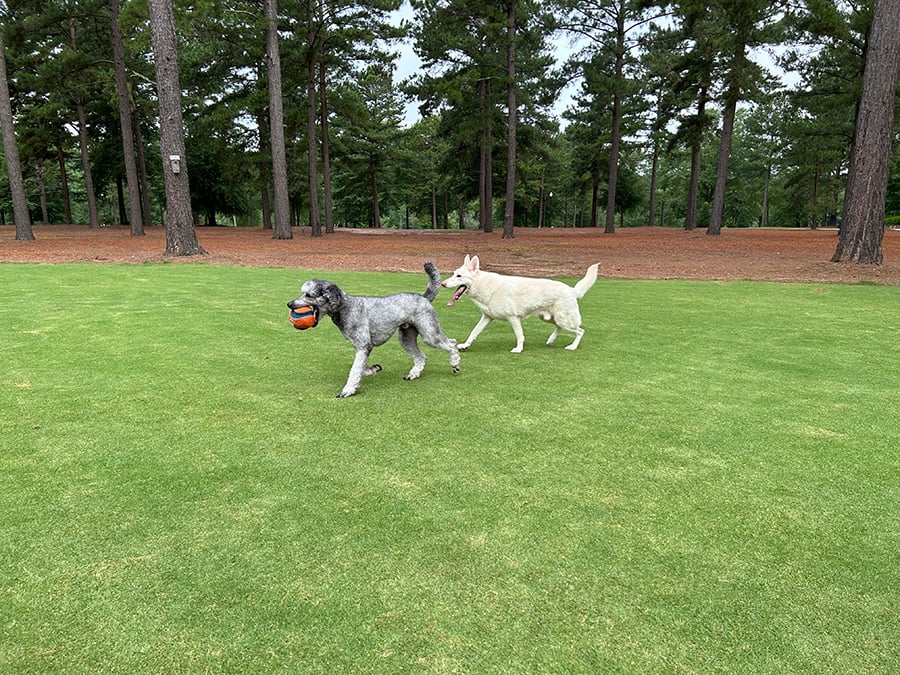
How Long will Pre-emergent Prevent Weeds?
Pre-emergents should be effective for 6 to 12 weeks and, as I mentioned earlier, a lot of that depends on how much rainfall you get during that period.

When to Apply Pre-emergent Herbicide?
We recommend applying pre-emergent 3 times a year: twice in the spring and once in the fall. Apply in February and April for the spring application, then in September for the fall application.
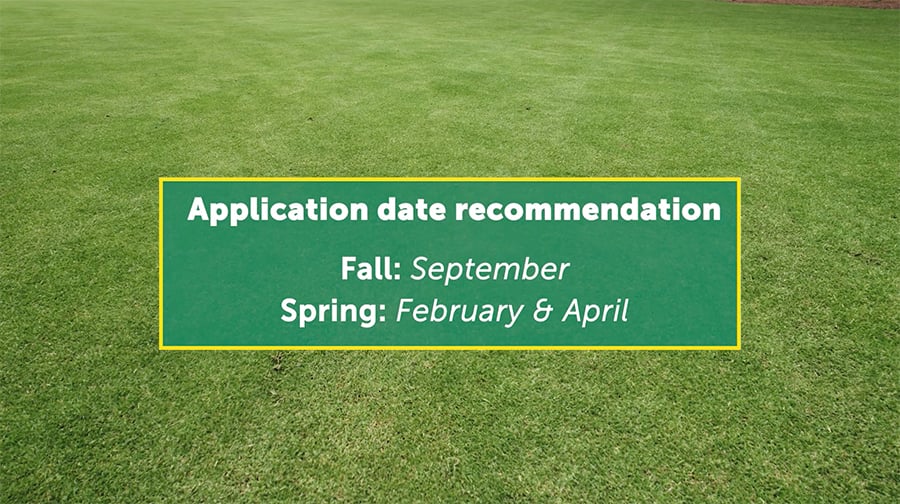
Spring Applications (2 Applications)
Ground temperature is critical for the performance of your pre-emergent. In the spring when ground temps rise to 55° that's when your weeds become active. It's not until the ground temps hit 65° that your lawn wakes up, and at 70° it's in full swing and has the ability to choke out those weeds on its own.
So what February and April pre-emergent applications are doing is providing you control from the 55 to 70° ground temperature window where the lawn is not vigorous enough to choke out those weeds on its own.
However, it's crucial to understand that the April pre-emergent application is the second half of a two part treatment - the February application being part one. The February treatment prevents most summer weeds, including crabgrass. The second April application works best in tandem with the first, so please note that if you didn't spread pre-emergent in February, and are only spreading in April, that you'll still see some summer weeds, such as crabgrass. Think of the April application like it's a booster shot.
Note: If you have a Centipede lawn, we recommend skipping the April pre-emergent application, and only applying twice a year - in February and September. We recommend this schedule because Centipedegrass is particularly sensitive to chemicals.
Fall Application (1 Application)
In the fall it's exactly opposite - you should to put out pre-emergent in September when your ground temperature lowers to 65° (and before it lowers to 55°). Winter weeds become active in that ground temperature window and pre-emergent will provide the control you so you don't see those weeds through next spring.
Note: If you plan on planting Tall Fescue seeds, skip this fall pre-emergent application.
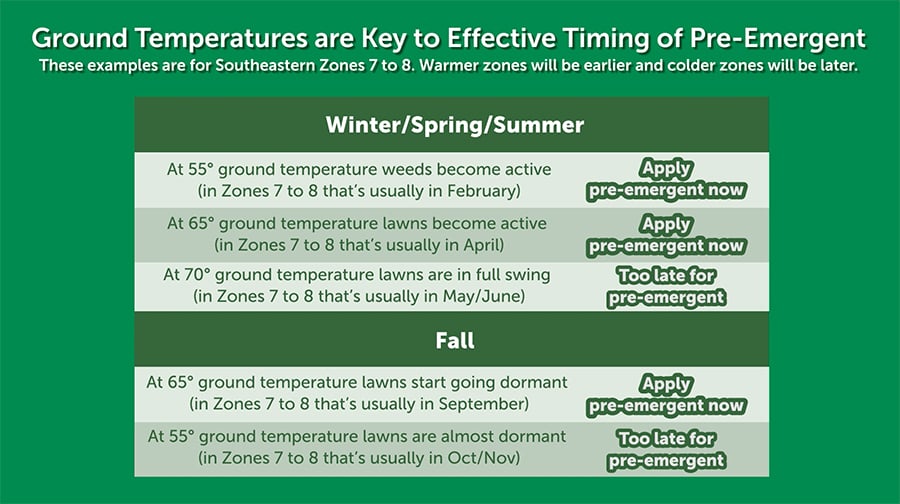
When is Pre-emergent Safe to Apply to a New Lawn?
Because pre-emergent's job is to form a chemical ground barrier and prevent root growth, you need to be cautious when using pre-emergents in the timeframes before and after starting a new lawn. The following are our guidelines.
Don't apply before you plant a new lawn: One thing you need to be aware of is if you plan on establishing a new lawn by way of sod or seed, you shouldn't apply pre-emergent beforehand. If you have applied pre-emergent, wait for 3 to 4 months until you plant seed or lay sod.
Wait after you plant a new lawn: It's safe to apply pre-emergent after one full growing season when your lawn in fully rooted in and you can no longer pull up areas of the sod, after you’ve mowed it at least three times, and after you can no longer see the seams.
If you laid warm season sod in autumn, chances are it will need one full growing season (summer) to root in and fill in the seams, thus skipping the February and April applications. If you laid sod in the autumn, here is a general application timetable:
- Zoysia - Safe to apply after Zoysia sod is 12 months old
- Centipede - Safe to apply after Centipede sod is 12 months old
- Bermuda* - Safe to apply after Bermuda sod is 6 months old
- Tall Fescue - Safe to apply after Tall Fescue is 4 months old
*TifTuf Bermudagrass is the quickest sod to establish and beats expectations for filling in the seams. If you lay the TifTuf Bermudagrass variety late summer and it’s fully rooted in and no seams are visible, it’s safe to apply the February and April applications of pre-emergent herbicide.
Pre-emergent Herbicide Alternatives
First off, if you don't use pre-emergent, you ARE going to end up with a whole lot of unsightly weeds - the worst part of that is a lot of them are going to be hard to control grassy weeds. I used Poa annua as an example before - that's a very difficult weed to control with post-emergent herbicide and very expensive to get rid of. Pre-emergent simply is the best option because it stops Poa from even emerging.
So, what are the alternatives to using a pre-emergent?
- Hand Weeding: In conjunction with pre-emergent herbicide, we recommend a willingness to get out there and do some hand weeding where there are spots that are missed by the pre-emergent.
- Mowing: Another option is mowing to prevent your weeds from going to flower, thereby breaking the weed's natural lifecycle of going to seed and creating more weeds. Yes, that may mean you mow a dormant warm-season lawn if weeds have gotten out of hand.
- Post-emergent Herbicides: These are also an option, but there are several things to keep in mind when using them:
-
-
- Most post-emergent herbicides work best when air temperatures are over 65 so that limits their effectiveness in winter.
- There is higher product use when using post-emergents, so if you're trying to reduce chemical usage, then post-emergent is not the best option.
- There's also going to be injury to turfgrass by using post-emergent herbicides - even if a post-emergent is labeled safe for your variety of turf, there's still going to be some injury there, you have to expect that.
- There's a potential for injury to lawns, ornamental plants, and vegetable gardens when using post-emergent liquid herbicides that may drift away from where you actually spray them. Even this slightest breeze can cause "spray injury" or "drift injury" of that sprayed liquid post-emergent herbicide.
-
Subscribe to Lawn Coach
We've talked about how important the timing is with pre-emergent with the weather, the ground soil temperatures, and upcoming conditions.
If that seems a little overwhelming to you, we have a solution for you and it's Lawn Coach.
Lawn Coach is a subscription based program where we send you the products that you need for your lawn when you need them and we take all that guesswork out of it for you. But there's more than just pre-emergents and fertilizers for you, we offer consultations, virtual visits, and annual soil testing that we actually go over the results with you to keep your lawn on track.







